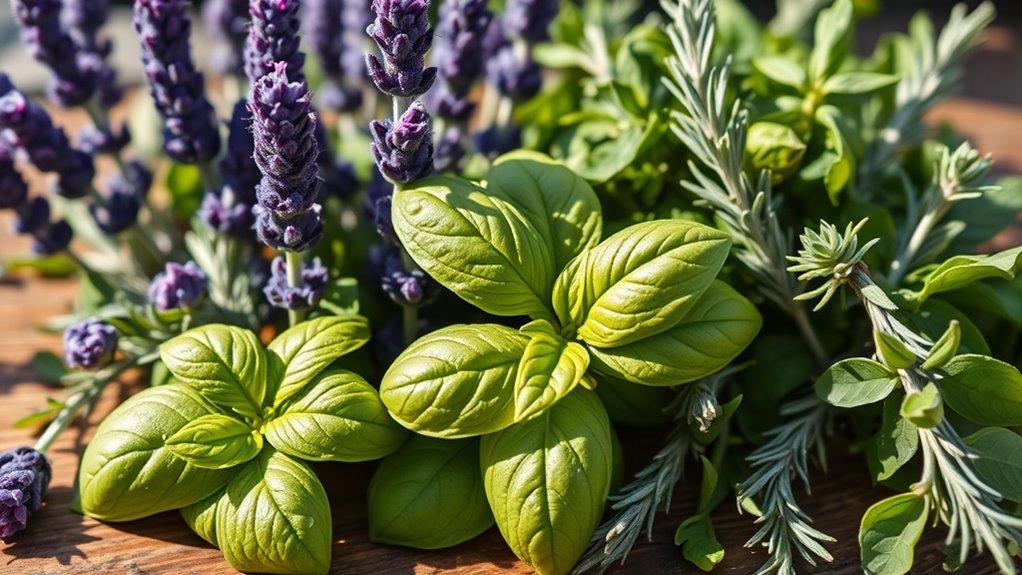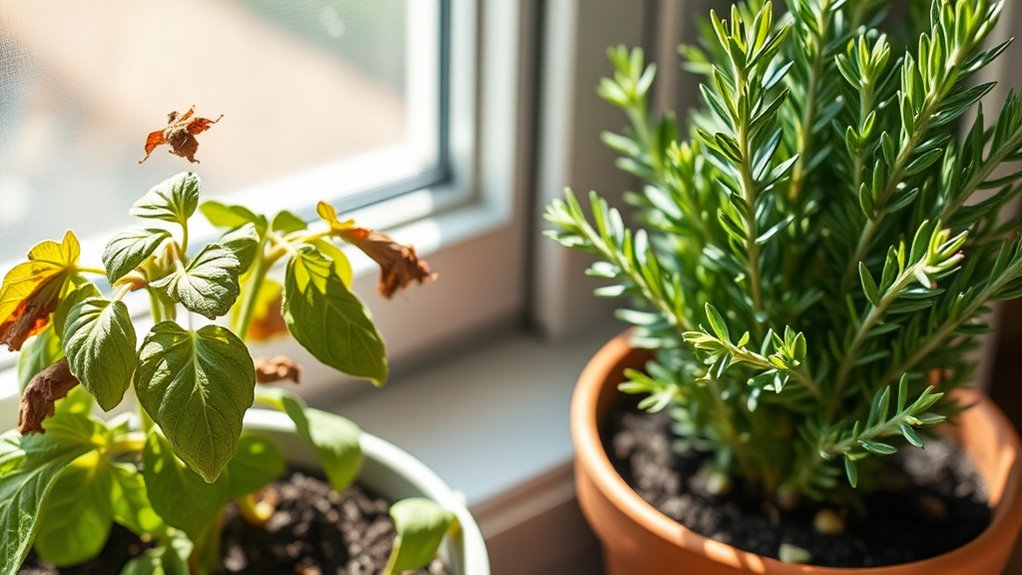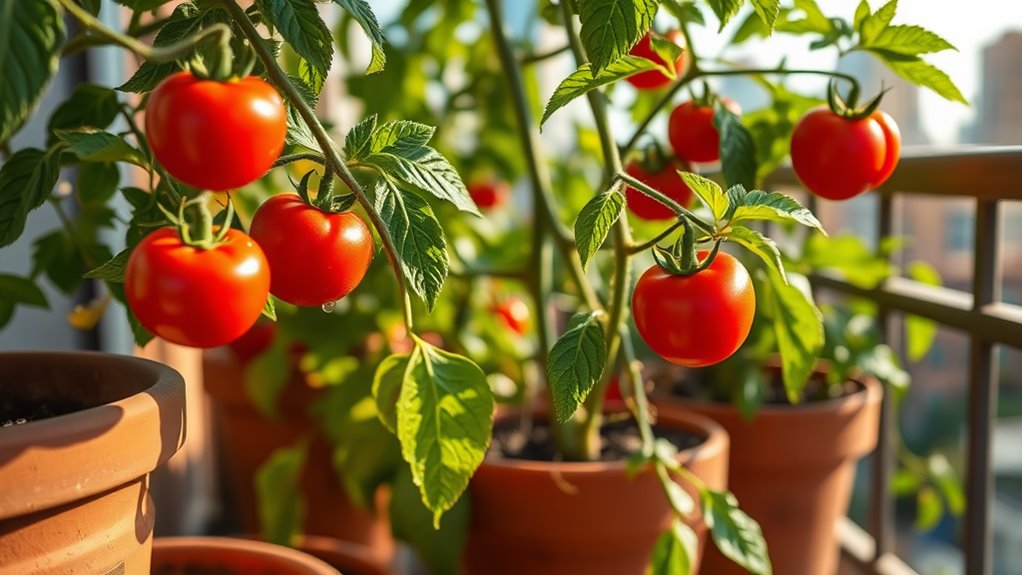These Herbs Keep Pests Away – Naturally!
You can naturally keep pests like mosquitoes, flies, and aphids at bay with herbs such as citronella, basil, rosemary, lavender, thyme, garlic, and mint. These plants release essential oils that disrupt insects’ sensory systems—citronella blocks mosquito scents, basil’s eugenol repels flies, and rosemary’s camphor deters aphids. Plant them in sunny, well-drained spots, crush leaves for sprays, or interplant for protection. Combining these boosts their power, so let’s explore even more strategies ahead.
Key Takeaways
- Citronella repels mosquitoes naturally through lemongrass-like oils that disrupt their scent detection.
- Basil deters flies and pests with eugenol, making it effective for garden and home protection.
- Rosemary’s essential oils, like camphor, naturally repel aphids and mosquitoes in sunny spots.
- Mint’s menthol compounds keep ants and flies away when planted around borders or crushed for sprays.
- Combining herbs like basil and thyme boosts defense against beetles and spiders through synergistic effects.
Herbs That Repel Mosquitoes
Because mosquitoes can turn a pleasant evening into an itchy ordeal, you can rely on specific herbs like citronella and basil to repel them effectively.
These herbs for pest control leverage natural compounds; citronella emits lemongrass-like oils that disrupt mosquitoes’ scent detection, while basil releases eugenol to deter them. Additionally, these herbs contribute to effective pest control by offering a sustainable option that reduces reliance on chemicals.
You grow these plants in sunny spots or pots near entryways for maximum coverage.
To boost efficacy, you harvest and rub leaves on skin or diffuse essential oils.
This practical method reduces bites naturally, integrating herbs for pest control into your routine for safer outdoor enjoyment.
Incorporating these herbs helps maintain a healthy garden ecosystem by promoting natural pest control methods.
Using Mint for Insect Control
Mint proves effective for controlling a range of insects, much like other herbs you’ve used against mosquitoes.
You’ll find mint’s menthol compounds repel ants, flies, and aphids through strong aromas that disrupt their senses.
Plant it around your garden borders or in pots near entryways; it thrives in well-drained soil with partial shade.
Crush leaves to release oils for a quick spray solution, or interplant with vegetables for natural protection. Combining mint with other natural pest sprays can provide even more robust defense against common garden invaders.
Regularly prune to maintain potency, ensuring you maximize its pest-deterring effects without chemical interventions.
Always monitor for overgrowth to avoid overwhelming other plants.
By integrating mint, you can enhance eco-friendly methods in your garden for overall pest management.
Basil as a Natural Bug Barrier
Basil serves as a potent natural barrier against pests, thanks to its essential oils that disrupt insects’ sensory systems. You can plant it strategically around your garden or pots to repel aphids, flies, and mosquitoes, as compounds like eugenol overwhelm their scent detection. Additionally, pairing basil with tomatoes can enhance tomato growth and flavor for better garden results.
For best results, grow basil in full sun with well-drained soil; it thrives and releases more oils when pinched regularly. You might crush leaves to release the aroma or brew a simple spray by steeping them in water, applying it to vulnerable plants.
This approach keeps your space pest-free naturally and sustainably. To enhance garden health and yields, try companion planting basil alongside vegetables like tomatoes for mutual benefits.
Rosemary’s Pest-Deterring Properties
You can leverage rosemary’s insect repellent effects to ward off pests like aphids and mosquitoes from your garden.
It’s a practical natural defense that integrates seamlessly into organic pest management strategies.
Start planting rosemary around vulnerable areas to enhance your plant protection efforts.
Incorporating rosemary into your garden supports natural DIY techniques for maintaining a healthier, more resilient environment.
Additionally, rosemary aligns with unconventional remedies that promote effective and chemical-free pest control.
Insect Repellent Effects
Rosemary’s essential oils, such as camphor and cineole, actively repel insects like mosquitoes and aphids, making it a practical choice for natural pest control in your garden.
These oils disrupt insects’ sensory receptors, masking plant odors they seek. You’ll notice rosemary’s volatile emissions create an invisible shield around nearby crops, reducing infestations effectively.
For optimal results, position plants in sunny spots for maximum oil production; their aromatic leaves deter pests on contact.
Experiment with varying rosemary varieties, like ‘Arp’ or ‘Tuscan Blue’, to match your climate and boost repellent strength in diverse settings.
Natural Garden Defense
While pests threaten garden vitality, rosemary’s compounds form a robust natural barrier against infestations.
You harness its essential oils, like 1,8-cineole and camphor, which disrupt insect feeding and reproduction.
Strategically, plant rosemary around vulnerable crops; its pungent scent repels aphids, beetles, and mites effectively. Intercrop it with vegetables for enhanced protection, and prune regularly to boost oil release.
Test soil pH first—rosemary thrives in well-drained, alkaline conditions.
Monitor your garden weekly; adjust placements if pests persist, ensuring a sustainable, chemical-free defense.
Lavender for Garden Protection
You can plant lavender in well-drained soil under full sun to establish a strong base for pest control. This method aligns with organic gardening practices that can lead to a more abundant yield.
Its essential oils emit scents that naturally repel insects such as aphids and moths.
Apply this herb around your garden borders to create a protective barrier against common pests.
Lavender is one of the resilient herbs that flourish with minimal care.
Lavender Planting Basics
For effective garden protection, plant lavender in a spot that gets full sun, as this promotes robust growth and enhances its pest-repelling oils.
You’ll need well-drained soil with a pH of 6.5-7.5 to thrive, and space plants 2-3 feet apart for air flow.
Plant in spring or fall, watering deeply initially but letting soil dry between sessions.
- Choose a hardy variety like English lavender for your climate zone.
- Dig holes twice the root ball’s width for proper root establishment.
- Amend soil with compost to boost nutrients and drainage.
- Mulch around bases to retain moisture and suppress weeds.
- Prune lightly after flowering to encourage bushier growth.
Pest Repelling Qualities
Lavender’s essential oils release a potent scent that effectively deters pests like mosquitoes, aphids, and moths, making it a natural guardian for your garden.
The key compounds, such as linalool and linalyl acetate, interfere with pests’ olfactory systems, masking attractants and causing avoidance.
You’ll notice mosquitoes become disoriented by the aroma, reducing their activity around you.
Aphids sense chemical disruption, leading to decreased feeding.
Moths find the fragrance overwhelming, halting their approach.
Technically, these oils evaporate to form a repellent barrier.
Practically, you’re harnessing this to minimize pest issues efficiently.
Protection in Gardens
Incorporating lavender into your garden creates a natural barrier that shields plants from pests.
It’s a practical, chemical-free strategy that repels insects like aphids and moths through its strong aroma and essential oils, enhancing your garden’s health and biodiversity.
-
Position it strategically: Plant lavender along borders or between vulnerable crops to form a protective ring.
-
Choose companion plants****: Pair it with roses or vegetables like tomatoes for mutual benefits against pests.
-
Maintain optimal growth****: Ensure full sun and well-drained soil to maximize its repellent properties.
-
Harvest for dual use****: Cut blooms to make sachets or oils, extending pest control indoors.
-
Monitor and prune: Regularly trim plants to encourage bushy growth and sustained effectiveness.
Thyme’s Role in Bug Prevention
Thyme effectively repels a variety of pests, thanks to its potent essential oils like thymol, which disrupt insects’ nervous systems. You can integrate thyme into your garden by planting it near vulnerable plants, as it targets aphids, mosquitoes, and ants through its strong aroma and oils. This natural approach minimizes chemical use while boosting plant health. Incorporating thyme into companion planting strategies can also promote overall garden vitality by enhancing growth and deterring additional pests.
| Pest | Mechanism | Practical Tip |
|---|---|---|
| Aphids | Nervous system disruption | Plant alongside vegetables |
| Mosquitoes | Scent-based repulsion | Use in outdoor pots |
| Ants | Trail interference | Scatter fresh leaves |
You’ll see results quickly if you maintain thyme in sunny spots, ensuring effective, eco-friendly pest control.
Drawing from personal garden experiments, thyme stands out as one of the most reliable organic pest remedies.
Garlic as an Effective Repellent
Garlic packs a punch as a natural repellent, thanks to its sulfur-rich compounds like allicin, which disrupt pests’ sensory systems and drive them away.
You’ll find it simple to use garlic in your garden, repelling insects without harsh chemicals. It’s effective against common pests, and you can prepare it at home for immediate results.
-
Prepare a spray: Crush garlic cloves and steep in water overnight for a potent solution.
-
Target key pests: Use it on aphids, mosquitoes, and spider mites to interrupt their feeding.
-
Apply regularly: Spray plants every few days, especially after rain, for lasting protection.
-
Combine with others: Mix garlic with herbs like thyme for enhanced repellent effects.
-
Store safely: Keep your garlic mixture in a cool, dark place to maintain its potency.
Sage for Home and Outdoor Use
You can harness sage’s indoor benefits to repel common household pests like flies and moths in your living spaces.
Place potted sage near windows or in kitchens for practical, natural protection.
Outdoors, plant sage around your garden borders to actively defend against insects and rodents.
Indoor Sage Benefits
Sage, a versatile herb renowned for its pest-repelling qualities, enhances indoor spaces by naturally deterring insects like moths and flies. You’ll find it’s an easy, eco-friendly addition to your home, repelling pests while purifying the air and adding a fresh aroma.
-
Plant it indoors: Position sage pots near windows to maximize sunlight and airflow, optimizing its essential oils.
-
Target common pests****: Use it against flies and moths by placing bundles in kitchens or closets.
-
Harvest regularly: Snip leaves to encourage growth and release more repellent compounds.
-
Combine with routines: Integrate sage into your cleaning by brewing it into sprays for surfaces.
-
Monitor effectiveness: Check for reduced insect activity weekly to adjust placement as needed.
Outdoor Pest Defense
While sage effectively repels pests indoors, it extends those benefits to outdoor areas by forming a natural barrier against insects like mosquitoes and beetles.
You can plant it around garden edges or patios to leverage its aromatic oils, which disrupt insect sensory systems. Choose drought-tolerant varieties such as Salvia officinalis for sunny spots with well-drained soil.
Regularly prune to encourage bushy growth and maintain repellent potency. Integrate sage into companion planting; it protects vegetables from aphids and cabbage moths without chemicals.
Monitor for overgrowth to ensure effective pest control in your outdoor spaces.
Cilantro Against Common Pests
Cilantro serves as a potent natural deterrent against common pests like aphids and spider mites. You can harness its strong scent and compounds to shield your garden organically.
It’s simple to incorporate into your pest management routine, boosting plant health without chemicals.
-
Plant strategically: Sow cilantro near susceptible crops to create a protective barrier.
-
Optimize growth: Ensure full sun and well-drained soil for maximum pest-repelling efficacy.
-
Monitor effectiveness: Check leaves weekly for reduced aphid populations on treated plants.
-
Harvest wisely: Regularly trim cilantro to promote bushier growth and sustained defense.
-
Integrate maintenance: Water consistently to keep cilantro vigorous, enhancing its natural repellents.
Combining Herbs for Enhanced Defense
By combining various herbs, you boost their pest-repelling power through synergistic effects, creating a stronger, multifaceted barrier in your garden.
For instance, pair basil with mint; basil’s oils target flies, while mint’s scent deters ants, broadening the defense spectrum.
Add rosemary and thyme for enhanced volatility—their compounds interact to amplify repellency against beetles and spiders.
Strategically interplant these in rows or borders around vulnerable crops, rotating based on pest activity.
Test combinations in small plots first, observing efficacy to refine your setup.
This practical synergy minimizes chemical use while fostering a balanced ecosystem.





